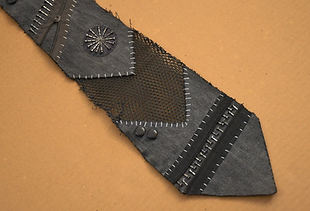
What began as childhood curiosity turned into a meaningful practice!

Suranjana Dhar, a third-year textile design student at NIFT Gandhinagar with a lifelong passion for creating, shares her story with us. From a young age, she’s been drawn to crafting—especially using materials others might call garbage. As a dedicated hoarder of what many consider useless, she believes that every discarded item holds the potential to be transformed into art. Alongside her work with found materials, she also enjoys illustrating caricatures and creating live watercolor paintings.
Tell us a little about your journey as an artist.
My journey as an artist began when I was four. To keep me occupied, my mother gave me a book of animals—and I ended up drawing a rhinoceros from it almost perfectly. She was stunned. That moment sparked something, and she began finding art teachers to help nurture my interest. Each one introduced me to new mediums and fresh ways of thinking about art. But despite learning a lot, I kept moving from one teacher to another, never feeling completely content.
It wasn’t until I was fourteen that I realized why: I felt most alive when I was creating on my own—without instructions or expectations. That’s when I stopped taking classes and began forging my own path, experimenting with everything I’d absorbed over the years, and letting instinct and curiosity lead the way.




What inspired you to start creating with discarded or “useless” materials?
When you're exploring so many mediums, how do you decide which idea to pursue?
I’m Bengali, and in our everyday routine, the afternoon nap holds a special place. After lunch, the whole house would slip into a restful silence. I was expected to join in, but I always saw it as a missed opportunity—for fun. And for me, fun meant opening up my cupboard, my little treasure trove, and diving into a new creative project.
As I grew older, that habit stuck. I became the unofficial inspector of all things about to be thrown away. Before anything was discarded, it came to me—and more often than not, I’d keep it. What began as childhood curiosity turned into a meaningful practice: transforming what others saw as useless into something imaginative and full of life.
The medium I choose depends entirely on the mood of the day. Some days call for the softness of watercolours, others feel better expressed through bold digital caricatures—or even a playful clay sculpture. Each medium has its own charm, and I let the day decide which one gets to speak.
How do you know what’s worth keeping from the junk — is it instinct or potential you see?
I tend to see potential in every scrap of junk, which means I end up keeping almost everything—often making my room look more like a storage unit. But I’m rarely disappointed. Somehow, even the most random things find their purpose eventually... though you never quite know when that moment will come.


What’s the strangest or most surprising object you’ve ever turned into art?
Created a tie using nails, broken zippers, and net fabric.

Is there a particular project that challenged you in unexpected ways?
It wasn’t a specific project, but a medium that challenged me for the longest time—watercolour. For years, it felt impossible to work with. No matter how many times I tried, the results were never what I imagined. Eventually, I convinced myself that watercolour just wasn’t for me.
But something in me kept going back to it. And over time, with enough trial and error, I began to understand its rhythm. I realized that watercolour isn’t meant to be controlled—you simply guide it and let it unfold on its own. Once I stopped fighting it, it became one of my favourite mediums.

We came across the 3-D face murals that you make out of cardboard. What was the inspiration behind it?
The human face has always been my greatest inspiration—a subject that endlessly fascinates me. There’s an incredible depth and diversity held within such a small frame, with each face telling its own story. I’m drawn to that uniqueness and love capturing it in whatever medium I can.
What does success look like to you as an artist?
Success isn’t something I constantly chase. Instead, I focus on finding joy in every step of the creative process, and that approach has served me well so far. That said, I do dream of the day when my art fills gallery walls, glowing under bright lights at my own exhibitions. Until then, I’ll keep gathering and cherishing every piece in this little room of mine.
